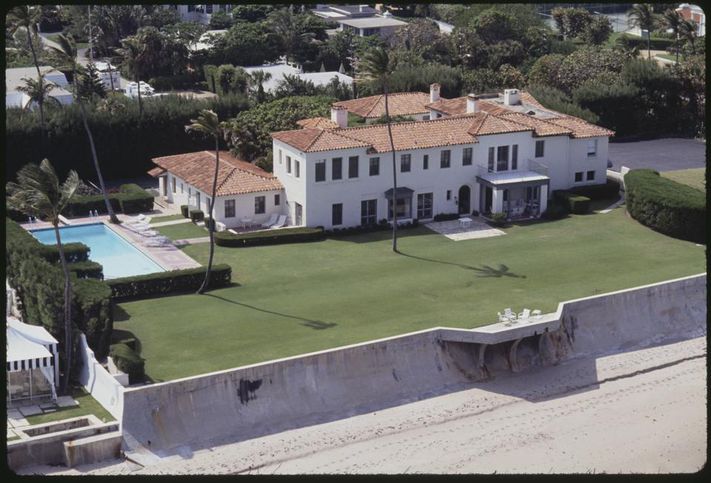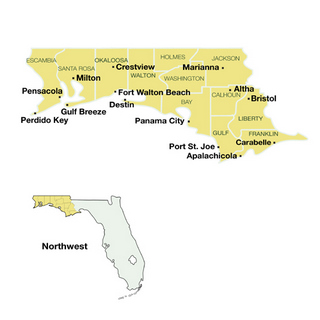- Home
- Florida Towns
- Palm Beach
- History of Palm Beach
HISTORY OF PALM BEACH, FLORIDA
By Mike Miller Updated February 19, 2023
The story of modern Palm Beach begins with Henry Morrison Flagler. Along with John D. Rockefeller, he was one of the founders of Standard Oil Company.
But before modern times, the area was inhabited by Native Americans.
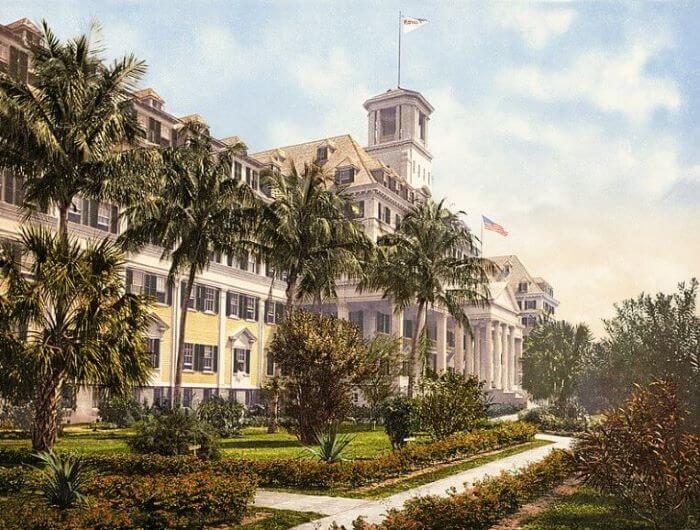 Royal Poinciana Hotel
Royal Poinciana HotelThe Jaega were a tribe who lived on the island that is now Palm Beach at least 3,000 years ago.
Like other original Florida tribes, they disappeared from the area after the long ownership of Florida by Spain and England.
The first white settlers began moving to the island in 1872.
The sparsely populated island saw its first exciting event in 1878.
That was the year a ship, the Providencia, was wrecked off the coast with a cargo of 20,000 Trinidadian coconuts.
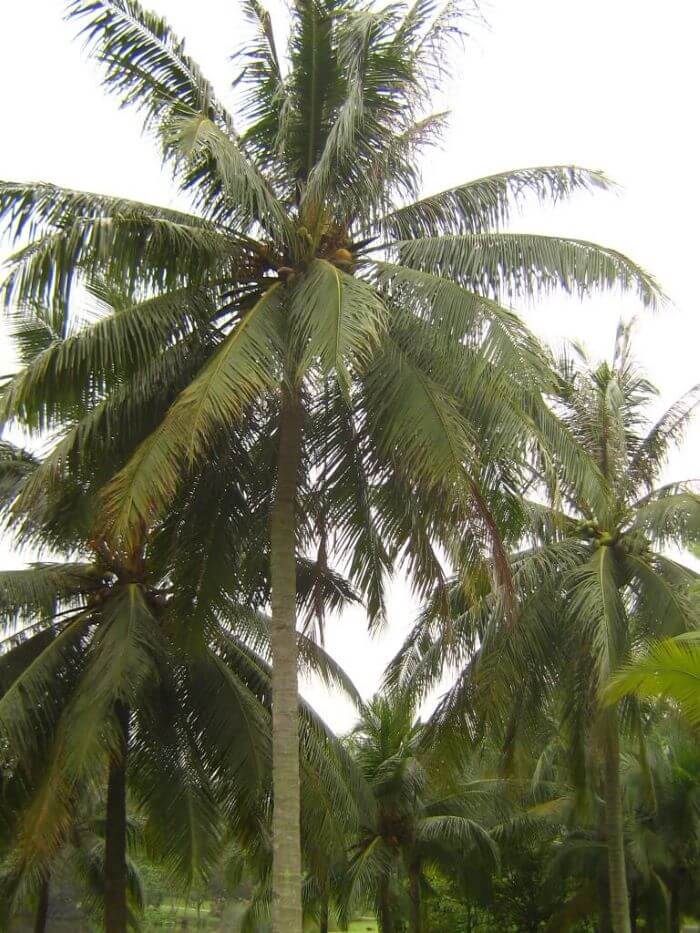 Coconut Palms
Coconut PalmsThe settlers salvaged them. After eating a bunch of them they planted the others all along the coast.
The coconut palms are not native Florida palm trees, but they thrived along this coast, and still do today.
The first hotel in the area was built in 1880 when "Cap" Dimick converted his home into the Cocoanut Grove House.
It was a pioneering venture known at the time as the only coastal hotel between Titusville and Key West.
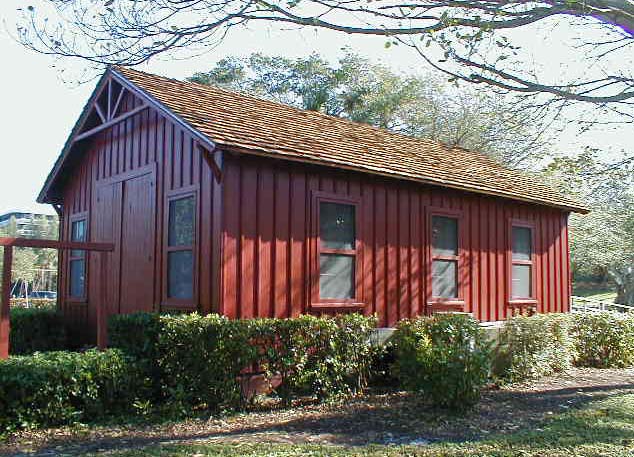 Palm Beach Little Red Schoolhouse
Palm Beach Little Red SchoolhouseThe first school opened in Palm Beach in 1886. It was known as the "Little Red School House."
Even though it went out of use as a school in 1901, it was renovated by the Gardener's Society of Palm Beach in 1960 and moved to Phipps Ocean Park..
HENRY MORRISON FLAGLER AND PALM BEACH
The story of modern Palm Beach begins with Henry Morrison Flagler.
Along with John D. Rockefeller, he was one of the founders of Standard Oil Company.
He retired from that business and become probably the most significant developer in Florida history.
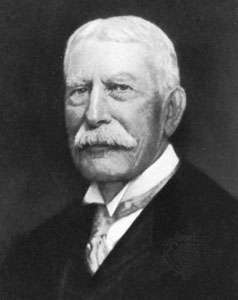 Henry Morrison Flagler
Henry Morrison FlaglerAfter leaving Standard Oil, Flagler visited St. Augustine with his wife in 1881. He loved the climate and the charm of the ancient city, but felt it needed better lodging and transportation.
He had the 540 room Ponce de Leon Hotel designed and built and it began hosting guests in January 1888.
The success of this venture led Flagler to begin purchasing short line railroads and to begin expanding his Florida East Coast Railway down Florida's Atlantic Coast.
The first hotel he built in Palm Beach was the 1,100 room Royal Poinciana Hotel on the shore of Lake Worth.
When completed it was the largest wooden structure in the entire world.
By 1894 he had extended the railroad all the way south to what is now West Palm Beach.
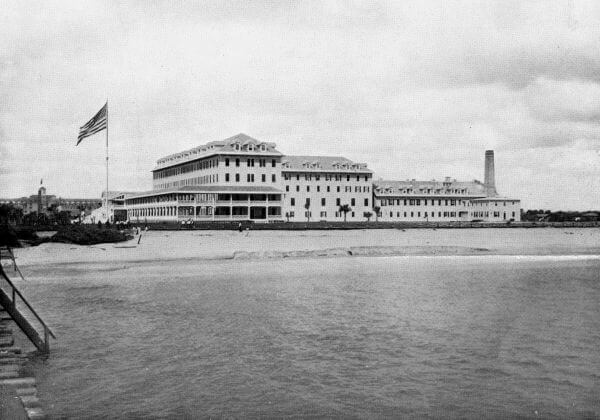 Palm Beach Inn, 1896, Burned in 1903
Palm Beach Inn, 1896, Burned in 1903Florida Memory
The next hotel he built was the Palm Beach Inn, which was renamed The Breakers in 1901.
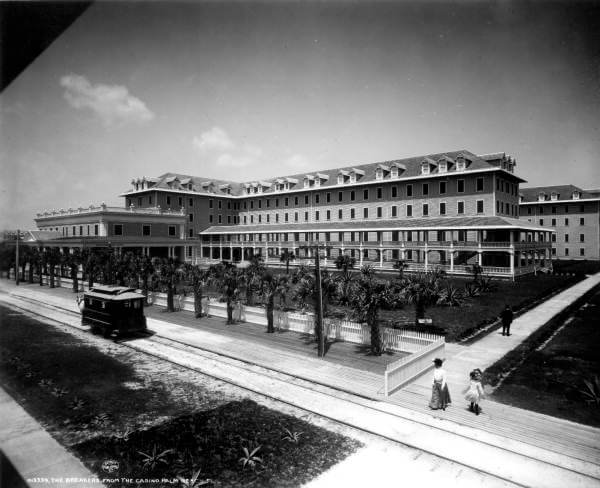 Palm Beach Breakers Hotel, 1901
Palm Beach Breakers Hotel, 1901Florida Memory
This hotel was on the beach overlooking the Atlantic.
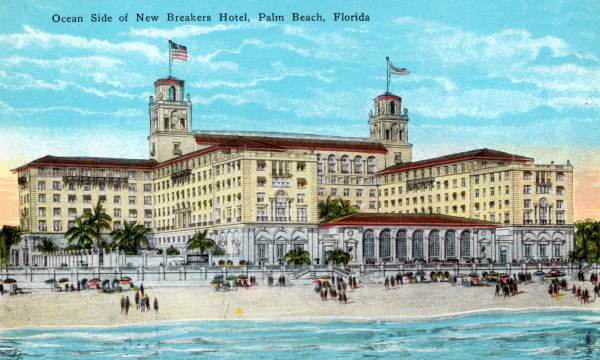 Vintage Postcard Breakers Hotel
Vintage Postcard Breakers HotelTHE SAD STORY OF PALM BEACH STYX
There was a community of black residents in Palm Beach who lived in a settlement named Styx, after the legendary name for the mythological river to hell.
Many of them became construction workers on the hotels that would be built in the future. Styx was in all regards a slum.
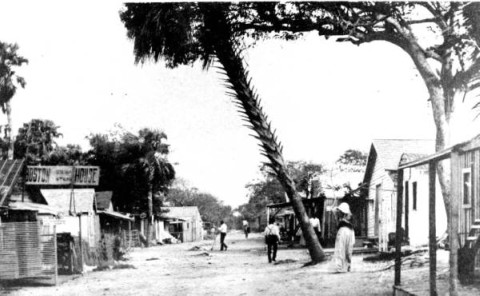 Styx Settlement in Palm Beach
Styx Settlement in Palm BeachFlorida Memory
Flagler wanted Palm Beach to be an exclusive retreat for the very wealthy.
He needed a place for the construction workers and hotel staff to live, so he created West Palm Beach across Lake Worth.
Palm Beach was incorporated as a town in 1911. Most residents of Styx were relocated to West Palm Beach by 1906 and the place was totally gone by 1912.
The circumstances of their relocation and the demolition of Styx are shrouded in mystery and have several different versions.
ALLIGATOR JOE ENTERTAINS PALM BEACH HOTEL GUESTS
 Alligator Joe's Pavilion
Alligator Joe's PavilionOne of the first tourist attractions in Palm Beach was a facility owned by "Alligator Joe", the nickname for Warren Frazee.
He was a large man who entertained hotel guests with exhibits of live alligators, crocodiles, and manatees.
 Whitehall, Henry Flagler's Home
Whitehall, Henry Flagler's HomeIn 1902, Flagler built a mansion, Whitehall, for himself and his wife.
His social life at Whitehall was instrumental in creating the "season" in Palm Beach. He entertained constantly, and his parties set the tone for the wealthy community.
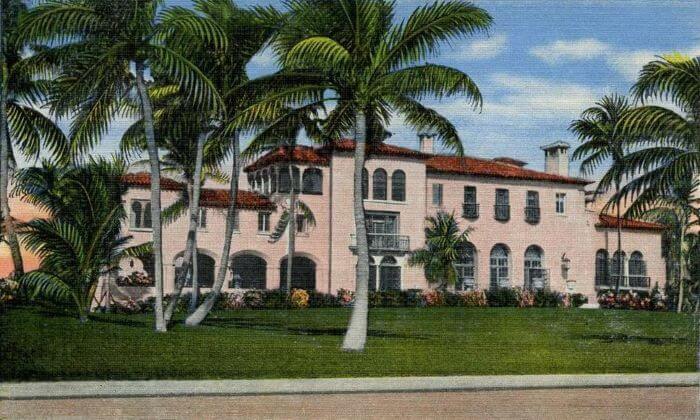 El Mirasol
El MirasolSome of the wealthiest people in the world began to stay at the hotels and build huge winter homes.
One of the first of these was Edward T. Stotesbury, who along with his wife Eva, had Addison Mizner build a mansion they named El Mirasol in 1919.
The estate stretched from the Atlantic Ocean to Lake Worth and was the scene of many fabulous parties for the rich and famous.
It was one the first large buildings in the Mediterranean Revival style that caught on and still defines Palm Beach to this day.
Other extremely wealthy people began to build mansions and the social scene got larger as the years went by.
Some famous early Palm Beach family names include Biddle, Munn, Phipps, Shearson, Wanamaker, Warburton and many others.
Among other Palm Beach structures designed by Addison Mizner are the Everglades Club done in collaboration with Paris Singer, and Via Mizner, a section of Worth Avenue.
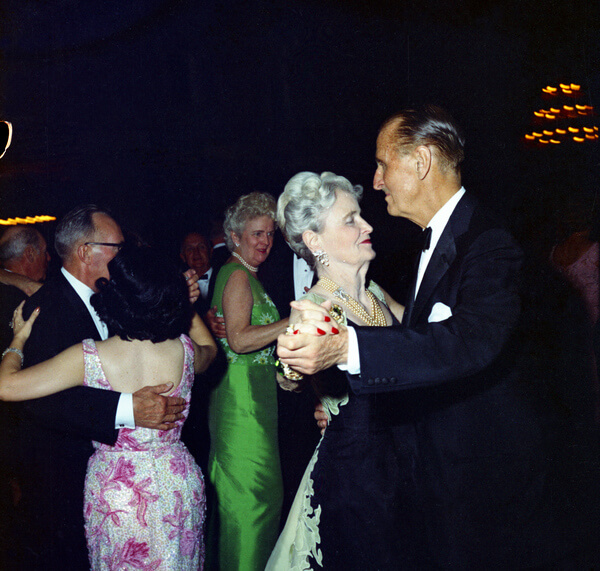 Mrs. Marjorie Merriweather Post Dancing With Col Serge Obolensky
Mrs. Marjorie Merriweather Post Dancing With Col Serge ObolenskyThe Breakers, Red Cross Ball, 1972, Florida Memory
For years one of the most famous Palm Beach socialites was Marjorie Merriweather Post.
She was the daughter of cereal tycoon C. S. Post and at age 27 inherited the Postum Cereal Company.
She was regarded at that time as the wealthiest woman in the United States.
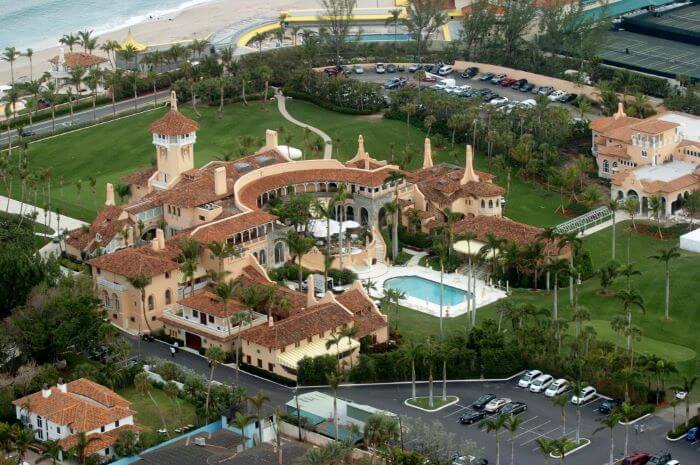 Mar-a-Lago
Mar-a-LagoShe built her Palm Beach estate, Mar-a-Lago from 1924 to 1927.
The 126 room, 110,000 square foot mansion became the scene of hundreds of social gatherings during her years in Palm Beach.
Future U.S. President Donald Trump bought Mar-a-Lago and converted it to a club.
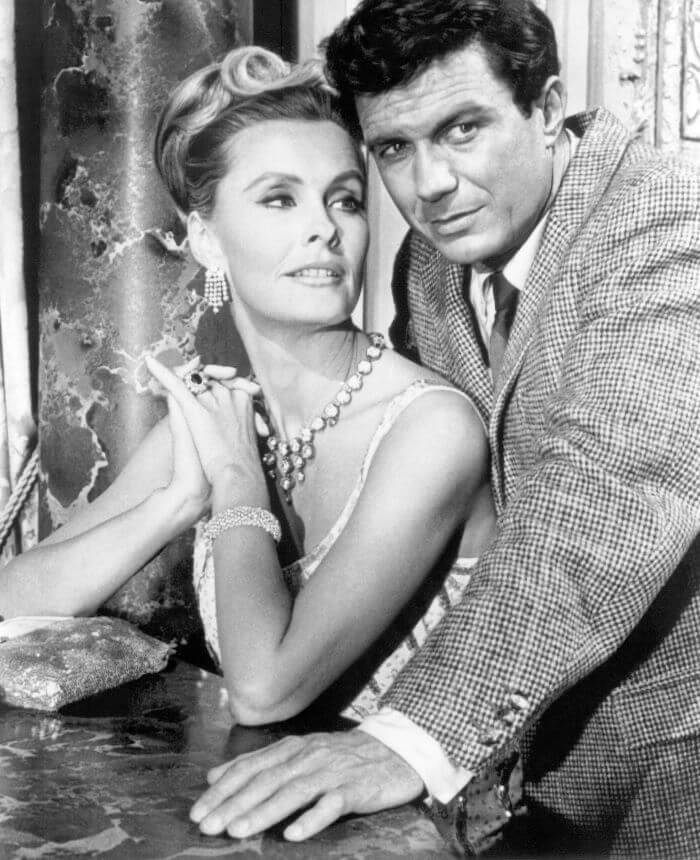 Dina Merrill and Cliff Robertson
Dina Merrill and Cliff RobertsonMrs. Post's daughter was the actress Dina Merrill, shown here with her husband, Cliff Robertson.
The patriarch of the famous political family, Joseph P. Kennedy, bought an oceanfront mansion on the ocean in Palm Beach in 1933.
Generations of the Kennedy family have vacationed there, and it was in essence the Winter White House during the presidency of John F. Kennedy.
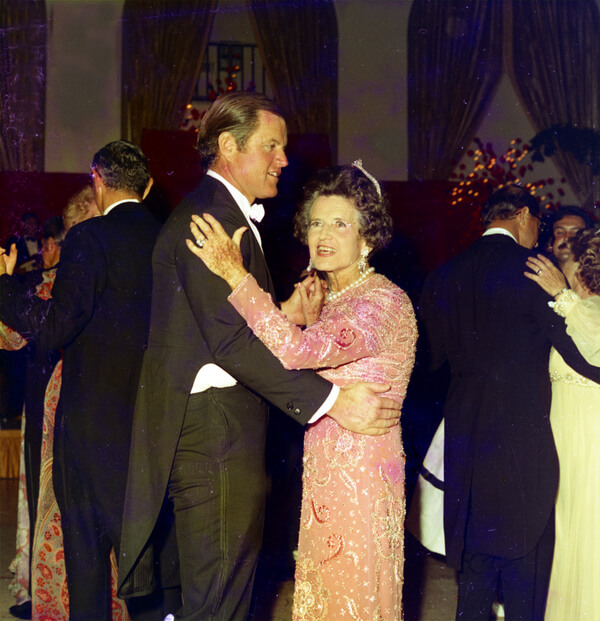 Senator Edward Kennedy and Mother, Rose Kennedy
Senator Edward Kennedy and Mother, Rose KennedyCharity Ball at the Breakers, 1972, Florida Memory
The estate has changed hands since the Kennedy family sold it in 1995. It has more than 15,000 square feet, 11 bedrooms, and 12 baths.
For a brief time, Palm Beach was the southernmost resort on Henry Flagler's Florida East Coast Railway.
A gigantic freeze later convinced him to extend the railroad to Miami and then eventually to Key West.
LEARN MORE ABOUT PALM BEACH TODAY
Our Facebook page has more than 130,800 followers who love off the beaten path Florida: towns, tourist attractions, maps, lodging, food, festivals, scenic road trips, day trips, history, culture, nostalgia, and more.
By Mike Miller, Copyright 2009-2025
Florida-Back-Roads-Travel.com
Florida Back Roads Travel is not affiliated with or endorsed by Backroads, a California-based tour operator which arranges and conducts travel programs throughout the world.
